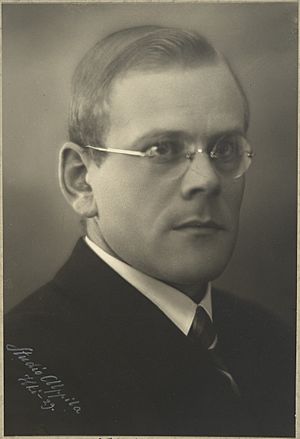Väinö Auer facts for kids
Väinö Auer was a famous Finnish scientist. He was a geologist (someone who studies Earth's rocks and soil) and a geographer (someone who studies Earth's features and how people live on it). He was born in Helsinki, Finland, on January 7, 1895. Väinö Auer is best known for exploring faraway places like Tierra del Fuego and Patagonia in South America. He also did important work on how bogs (wet, spongy areas of land) form, how deserts grow (called desertification), and studying layers of volcanic ash to understand past climates.
Contents
Early Life and Education
Väinö Auer was born in 1895. His father was a senator named Kyösti Auer. Väinö studied at the University of Helsinki in Finland. He earned his first degree in 1917 and his master's degree in 1918. He finished his Ph.D. in 1923. During his studies, he also took part in the Finnish Civil War in 1918. In 1929, he became a professor of geography at the University of Helsinki.
Exploring New Lands
While he was a professor, Väinö Auer went on exciting trips. He explored Tierra del Fuego in 1928–1929. This is a group of islands at the southern tip of South America. He also explored Patagonia in 1937–1938. Patagonia is a large region in South America, shared by Argentina and Chile.
Life in Argentina
After World War II ended, Väinö Auer moved to Argentina in 1946. He worked for the Argentine government as an advisor. He helped the government and the Central Bank with different tasks. During his time in Argentina, he kept studying the natural history of Patagonia and Tierra del Fuego. He also gave advice to the Argentine government about how to use land and settle new areas in the southern parts of the country.
Later Career
Väinö Auer returned to Finland in 1953. In his last years as a professor, he taught geography from 1953 to 1957. Then, from 1957 to 1963, he was a professor of geology and palaeontology at the University of Helsinki. He passed away in Helsinki on March 20, 1981.
A Documentary About His Work
In 2007, a documentary film was made about Väinö Auer's life and work. It showed his adventures in Finland and Latin America. The film explained that Auer was a geographer, explorer, and especially a swamp geologist. He used a special tool called a swamp auger. This tool helped him dig deep into the earth. He found layers of earth that showed the climate history from after the Ice Age. He did this in places like Canada, Finland, Tierra del Fuego, and Patagonia. The film takes viewers through different parts of Auer's life. It shows the swamps of Finland, the unique shallow swamps of Tierra del Fuego, and the windy plains of Patagonia. The documentary used notes from Auer's own diaries and articles to tell his story.
See also
 In Spanish: Väinö Auer para niños
In Spanish: Väinö Auer para niños


